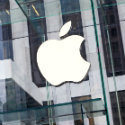
Take advantage of the new Apple One plan, launching today, and you might never have to leave your iHome again. The right app or Apple accessory will handily turn it into an office, gym, concert hall, cinema or games venue – depending on your mood. A virtual accompaniment to Amazon-delivered groceries, it is pandemic-era living for the well-off suburbanite.
The cult of Apple was always likely to be one of the COVID-19 winners. Its overpriced trinkets target Apple zealots and income brackets largely unaffected by the economic fallout so far. Its plunge into services could not have been timed better. Just as people are advised not to go out and socialize, the king of Cupertino pipes a welter of experiences direct to the home.
Yes, net profit fell 7% year-on-year in the September-ending quarter, to about $12.7 billion. But that was largely because research-and-development costs rose a fifth, to nearly $5 billion. Only myopic investors will punish a technology company for taking a hit to profits so that it can safeguard innovation.
Figure 1:  Apple CEO Tim Cook has good reason to be optimistic.
Apple CEO Tim Cook has good reason to be optimistic.
Revenues in the quarter, despite the economic pain, ticked up 1%, to $64.7 billion. And while there was a decline in product sales, the services business was on a roll, with revenues up 16%, to about $14.5 billion. "This was a record quarter," CEO Tim Cook told analysts. "Geographically, we set September quarter records in the Americas, Europe and Asia-Pacific."
Even before the launch of Apple One, the iPhone maker had clocked up 585 million paid subscriptions to its various services, an increase of 135 million in just a year. Apple is now hopeful it will beat its end-December target of 600 million paid subscriptions. As fanboys don spandex and fire up the newish Fitness+ app – now available through Apple One – the services outlook is sunny.
iPhone slump
What hurt Apple was the slump in iPhone sales that happened between July and September. In the first six months of the year, Apple shifted about $111 billion worth of iPhone stock, roughly 2% more than it did in the same period of 2019. Yet third-quarter sales fell 21%, to $26.4 billion. What happened?
"As we anticipated, we launched new iPhone models in October, a few weeks later than last year's mid-September launch," explained Cook. "Up to that mid-September point, customer demand for iPhone was very strong, and grew double digits."
Want to know more about 5G? Check out our dedicated 5G content channel here on Light Reading.
The model introduced was the iPhone 12, a device that appears to be all about 5G connectivity, with few other new features. No matter, because the market expects shipments to rocket in the current quarter as Apple enthusiasts pounce on the latest promotions.
"Obviously, 5G is a once-in-a-decade opportunity, and, as you've seen in some markets – certainly here in the United States – carrier offers are very aggressive," said Luca Maestri, Apple's chief financial officer. "And so that is very good for consumers and, ultimately, very good for us."
Omdia, an analyst firm and sister company to Light Reading, believes Apple shipped about 41.5 million iPhones in the recent third quarter, 10.2% down on the figure a year earlier.
"This year, Apple delayed the launch of its latest generation of iPhones until mid-October, impacting shipments in Q3 as the models will not reach consumers until the last week of October," it says in a research note that ranks Apple fourth in a table of smartphone makers.
Figure 2: Smartphone shipments (millions) and market share  Source: Omdia.
Source: Omdia.
Whether or not Apple's 5G move can lift it above third-place Xiaomi in the near future, sales grew in every other one of its product categories. The star of the show was the Mac, which generated more than $9 billion in quarterly sales, a 29% increase year-on-year. A retreat into residential man caves and kitchen offices may have triggered a round of spending on pricey new machines.
Despite all this, Apple's share price was down about 4% on the Nasdaq in before-hours trading today. At $111, it has fallen from an all-time high of $129.04, achieved on August 20. The dip could reflect Apple's unwillingness to provide a forecast for the holiday season, as well as general coronavirus gloom.
The real stunner is not this upset. It is that Apple's share price has nearly quadrupled in the last five years, valuing the company at around $2 trillion in the midst of the worst economic crisis in living memory. Connected gadgets and domestic online experiences are where COVID-19 fortunes are made.
Related posts:
— Iain Morris, International Editor, Light Reading
About the Author(s)
You May Also Like












